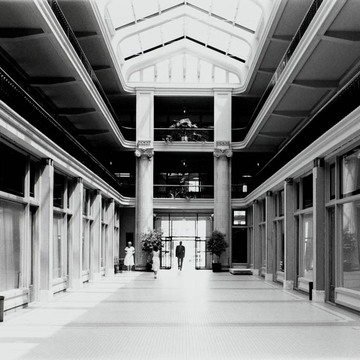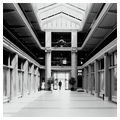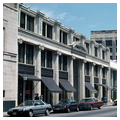Although common in Europe and found occasionally in the northeastern and midwestern United States, covered shopping arcades are rarer in the warmer climates of the American southeast. That Norfolk possesses two such buildings axially aligned on adjacent blocks is astonishing. Together they form a pleasant, if somewhat deserted, pedestrian spine that leads from Monticello Avenue and the center of downtown across East Plume Street to Martin's Lane and the waterfront.
The Monticello Arcade, the more distinguished of the pair, was constructed in anticipation of the surge in visitors to the city for the 1907 Jamestown Ter-Centennial Exposition. The local firm of Neff and Thompson designed a fireproof structure framed in reinforced concrete and clad in terra-cotta. The East City Hall Avenue and East Plume Street elevations are identical with engaged Ionic columns and split segmental pediments over centrally placed entrances. Inside, the well-proportioned, threestory atrium is illuminated by a gabled skylight. Galleries overlooking the main concourse at the upper levels are bounded by graceful iron railings. Although scaled for early twentieth-century commerce, the design of the Monticello Arcade is reminiscent of Warren and Bucklin's Greek Revival Providence (Rhode Island) Arcade (1828), America's first.
The success of the Monticello Arcade led to an attempt to extend southward, across Plume Street, a smaller, more modern arcade named after a prominent Norfolk family. The Selden Arcade is arranged on a single level with a concealed upper level at each end. Clerestory windows flood the main concourse with light. Only the south facade is original, and it is a handsome example of Art Deco design by a rather conservative Norfolk firm. A segmental arch with a chevron border spans the entrance portal, and stylized block letters announce the building's name to passing shoppers. To either side, abstracted fluted pilasters without capitals divide the facade into bays.
At one time both arcades were open to the street at each end. A Norfolk city ordinance requires that the owners of such buildings block public access to them annually for a brief period, lest they be declared public thoroughfares. At some point in the distant past, the owners of the Monticello Arcade evidently failed to comply with this ordinance, although it is unclear whether the city ever tested its authority in this matter. In any case, doors have since been added to both buildings. As with the rest of the downtown retail district, the arcades' fortunes declined after World War II with the

















